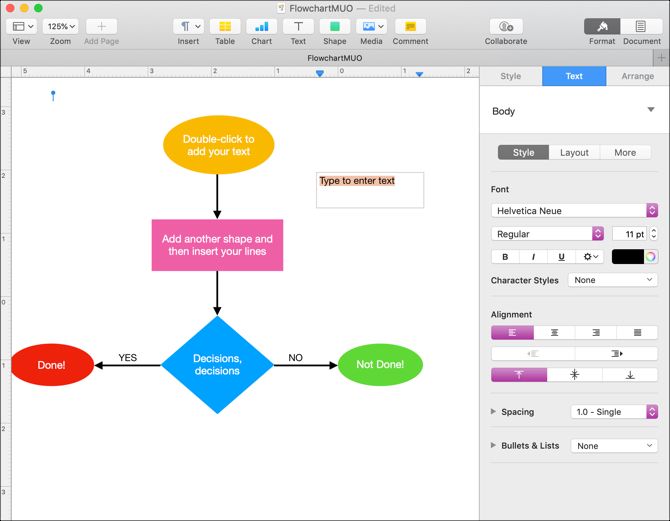
You can simply choose any graphic there and then modify it accordingly. In addition to your own shapes, you can use pre-saved options in Word that are stored in the SmartArt menu. To avoid modifying arrows every time, you can right-click on the one you like and select Set as Default Line. To name the step, just select your shape and start typing. In the Format tab, you can also add colors, outlines, and extra effects. You have all kinds of shapes (rectangles, diamonds, and ovals) at your disposal under the Flowchart header, and you also have a wide selection of lines and arrows under the Lines header.Ĭlick on any shape and draw it out with your cursor. Go to the View tab and check Gridlines.Īfter that, navigate to the Insert tab and click Shapes. Alternatively, you can start from scratch using the Shapes and SmartArt features in Word.īefore you begin, make sure to turn on the grid in Word to make your flowchart perfectly aligned.
#MAKE A FLOW CHART FOR OSX DOWNLOAD#
So you can start with some bases already covered if you download one. There are lots of Word flowchart templates online. Since Microsoft Word is the world’s most popular text editor, by extension it’s the go-to place to create flow charts as well.
#MAKE A FLOW CHART FOR OSX SOFTWARE#
Or you can use specialized flowchart software for Mac. Lots of people create flow charts in Microsoft Word. As a general rule, keep most flowcharts somewhere within 10 steps, unless you have a reason not to.įor the actual flowchart software, you have a few choices. The main thing to consider is that the steps you choose to outline should be actionable and detailed, but at the same time not so microscopic that the overall flowchart becomes hard to read. Now we just need to draw it out with shapes and arrows. For example, a customer calls ➙ greet them with an option menu ➙ forward their call to the most appropriate agent based on their selection.Īlready, you can see how we have a basic flowchart ready. The first step in making a great flowchart is to break down the process you’re trying to visualize into small and actionable steps. We’ll cover all these options in the sections below. Others are algorithmic logic, design, price, the ability to share with others and collaborate in real-time, etc. So when it comes to choosing your flowchart app, templates are one aspect you should consider. In fact, it’s preferable if you use templates - flowcharts are primarily for communicating information, not for exercising your artistic skills. Most flowchart software you encounter will actually have built-in templates you can use. The beginning and the end of a flowchart are drawn as an oval, every process step is a rectangle, and a decision is a rhombus. For example, flowcharts are read from top to bottom, and left to right. You can be creative with the shape you give the boxes and arrows you use in your flowcharts, or you can adhere to the universally accepted standards. Sounds simple enough, but in reality flowcharts are so flexible they can be used to outline even the most complex decision-making. Visually it looks like boxes with text in them that are connected by arrows (to represent logic).

But what are flowcharts exactly?Ī flowchart is a type of diagram that displays a certain process or workflow. So far, we’ve described what flowcharts are being used for - they improve processes and step by step thinking of any team. So let’s go over the most critical aspects of any flowchart and explore a few apps that will help you create the best flowcharts on the fly. Of course, not all flowchart software is equally effective. Flowchart software not only clarifies the thinking around any new project, it’s also accessible to all your coworkers at any time and might even cost less than an actual whiteboard. You might think, do we really need flowchart software? If you work in a team - probably yes.


 0 kommentar(er)
0 kommentar(er)
